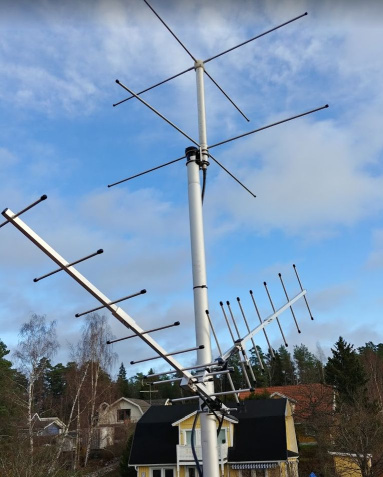You say the only antenna can beat the eggbeater is the TA-1 Turnstile… Had you tested the QFH?
https://network.satnogs.org/observations/3045483/
Received with UHF QFH without LNA
You say the only antenna can beat the eggbeater is the TA-1 Turnstile… Had you tested the QFH?
https://network.satnogs.org/observations/3045483/
Received with UHF QFH without LNA
You say the only antenna can beat the eggbeater is the TA-1 Turnstile… Had you tested the QFH?
I was speaking about VHF here, there is no TA-1 or similar available for UHF.
But if I compare https://network.satnogs.org/observations/3074174/, the UHF Eggbeater preforms very well, even at lower elevation as expected.
and here a comparison of UHF QFH (left) against UHF Eggbeater (right) on almost identical overhead passes with LUSAT
73 de Peter
A bit hard to compare when the waterfalls scaling is so different.
Is it?
Admittedly I don’t know the exact details of the passes there, but from those two waterfalls I can see that the eggbeater appears to have a higher SNR in the middle of the pass, and received lower down to the horizon.
The QFH does have a higher noise floor, which could be from antenna placement, or an antenna design which isn’t rejecting local noise well enough. It could be that the reason its not receiving the sat signal down to the horizon is its being obscured by local noise.
Where do you see a difference in scaling? Two identical overhead passes…
Many thanks for the picture comparing both antennas.
There is a small difference, I think you are comparing a non-LNA system with your LNA system.
But apart from that, is clear. I’ve always noticed that QFH is working fine above 18 degrees. I’m thinking on experiment with another tall-width relations to improve performance on lower passes…
You eggbeater is from Anjo Antennen?
73’s de EA5WA Juan Carlos
I’m still surprised how you all can get so good results with omni antennas for UHF. You must have a very noice free RF environment and QTH with free sky.
I’m convinced that the most important part of the satnogs station is the location.
I’m not free of QRM but I have free sky
Yes, we have the ANJo Eggbeaters for both UHF and VHF and in parallel a separate TA-1 for APT…
Indeed, we have good LNA 's on all antennas, but even so the Eggbeater gives very good coverage. The TA-1 goes down to 0° Elevation, but picks-up more noise etc sometime…
We are now testing a cavity filter on the APT for 137 MHz…
We also had extremly QRM from 70cm Repeater only 100m away, but it’s turned off now 
The location is at our 20m dish in Bochum, so it is supposed to be a little bit more quiet and has very good open sky coverage…
You can compare some observations here: https://network.satnogs.org/users/dk0sb/
73 de Peter
The QFH waterfall paints everything above -70dB in green or yellow.
The Eggbeater waterfail paints everything above -90dB in green or yellow.
Therefore, the QFH looks much “worse” visually, because it has a lot less green and yellow.
If both used the same scaling, it would be much easier to compare them visually.
So, I have reach to the final test - stacked yagis, fixed mounted. I’m using 8 el from Vinnant Antennas. When using just one Yagi I got good results from the direction where the antenna pointed, but of course none from the other directions.
Now I have stacked two Yagis, one is vertical and the other one horizontal. Az/El is 270/45 and 90/45.

And I got two similar passes from Bugsat that can be used to compare:
The vertical Yagi decoded 3 packets in this pass:
The horizontal Yagi decoded 6 packets in this pass:
So what I will do now is the switch the vertical yagi to be horizontal and see if I can get better result.
Why do you think horizontal polarization is better only looking to one pass? Satellite is constantly changing its position
@ea5wa Yes I know that polarisation from satellites is changing during a pass. The above was a good example but I have many more passes with similar results.
This is actually just a fun test - no professional test results can or ever will be published be me  All I’m doing is on amateur basis and for fun…
All I’m doing is on amateur basis and for fun…